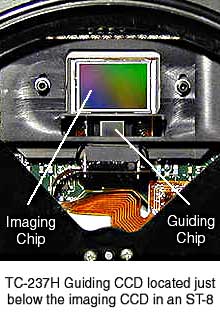
No telescope drive system is perfect. All have small flaws in their drive gears
that cause the telescope to speed up or slow down periodically. These drive train
errors (and gradual declination drift from not being precisely aligned on the celestial
pole), can cause the stars in long exposure photographs to develop small tails or
elongate unnaturally. For the sharpest long exposure photos, the telescope should
be guided during the exposure, speeding up or slowing down the drive to compensate
for the unavoidable unwanted telescope motions as they happen.
Many SBIG CCD cameras are self-guiding, making the telescope's right ascension drive
and declination drift error corrections automatically during the course of a long
exposure. This means that you don't have to stay glued to a crosshair guiding eyepiece
during the entire exposure to correct for those errors manually. You can even leave
the telescope entirely, letting it guide and take its photographs automatically.

The self-guiding SBIG cameras use two CCD detectors, one is a Kodak 657 x 495 pixel
TC-237H detector for guiding, while the other is a larger detector for collecting
the image. The detectors are mounted in close proximity to each other within a single
camera body. Both are focused at the same image plane. This patented guiding method
allows you to focus both taking and guiding detectors simultaneously.
Some competitive cameras have a separate guiding detector that mounts in an off-axis
guider body. This two-housing system requires more setup time to focus each detector
independently than does the one-time focus of the SBIG cameras. Still other cameras
have one detector, but use a portion of that detector to guide while the balance
of the detector collects the image. By using a completely separate internal CCD
for guiding, the SBIG cameras allow 100% of the imaging CCD to be used to collect
the image, an improvement over other single chip designs.
In SBIG tests performed under moderate light pollution with an 8" f/6.3 telescope,
randomly pointing the telescope with a self-guiding SBIG camera in it toward objects
in relatively star-poor areas of the sky away from the Milky Way resulted in stars
on the guiding detector being bright enough to be used for guiding 95% of the time.
TheSky
software from Software Bisque (supplied with each camera) can print finder charts
showing the correct placement of the guiding detector's field of view relative to
the imaging CCD's field of view. Using this software tool to plan your nights imaging
will help you orient the camera for proper guide star acquisition in those few cases
where a bright-enough guide star might not be immediately apparent.








